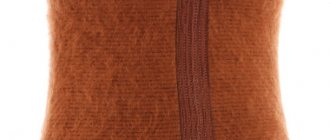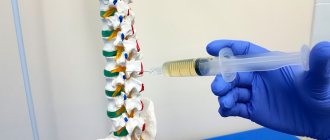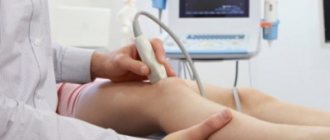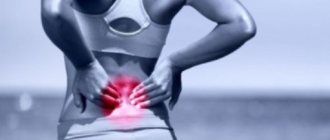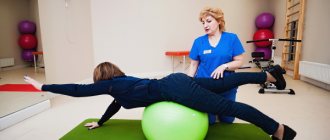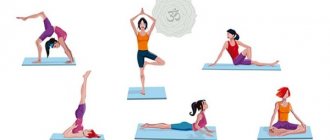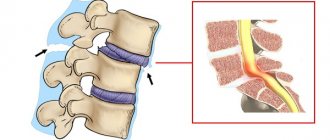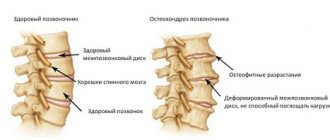Back pain
- a common complaint. Usually we talk about back pain when pain is felt in the lumbar region. Sometimes in such cases they say that “the back is pinched.” According to recent studies, out of every five people, four have experienced such pain at least once in their lives. Read more about lower back pain>>>
Another typical location of back pain is under the right or left shoulder blade or between the shoulder blades. Read more about pain under the shoulder blade>>>
With age, back pain is more common - among older people, every second person experiences such pain from time to time.
Back pain can have a different character: it can be sharp, stabbing, burning, aching, pulling, and can radiate to other parts of the body (for example, to the chest, legs, abdomen, genitals). The pain may be occasional or constant.
When listening to pain, a person usually asks himself two questions: should he see a doctor, and which doctor should he go to for back pain? Let's try to answer these questions.
Causes of back pain
Back pain can be caused by various reasons. Only an experienced doctor, based on an examination of the patient and data from laboratory and instrumental studies prescribed by him, can correctly diagnose and prescribe an effective course of treatment.
Back pain can be caused by:
- neurological diseases: spinal osteochondrosis (degenerative damage to the intervertebral discs);
- spondyloarthrosis (degenerative changes in the intervertebral joints);
- spondylosis (deformation of the vertebrae due to the proliferation of bone tissue);
- herniated intervertebral discs;
Such a variety of possible causes makes a person think about which doctor to contact for back pain. But this should not be turned into an obstacle to the help that professional medicine can provide.
Manual therapy and osteopathy. Hand treatment
People turn to an osteopath for back pain, headaches, gastrointestinal diseases, chronic fatigue syndrome, and gynecological problems. The success of treatment largely depends on the skill of the individual osteopath or chiropractor.
A good osteopath can use his hands to relieve spasms, compression of nerve roots, realign displaced vertebrae, and thus relieve spinal pain and other symptoms, such as numbness of the limbs. This gives a longer-term effect than drug treatment. But osteopathy, in fact, has no effect on the root cause of the development of pathologies.
, due to which compression of nerves, displacements, spasms occurred, gradual destruction of discs and joints began with the formation of disc herniation, protrusion, spinal canal stenosis, etc.
Pathological factors remain, so sooner and later the pain returns, intensifies, the person becomes hostage to pharmacies, chiropractors, doctors who administer medicinal “blockades”, to the chronically ill and dependent.
General conclusion
. Neither medications, nor ultra-modern spinal traction devices, nor lasers, nor sessions with a chiropractor can relieve disc herniations and other diseases of the musculoskeletal system.
Applied kinesiology
In order to truly recover, get rid of pain, chronic exacerbations, you must first identify and then eliminate the causes that provoke the destruction of osteochondral tissue, lead to the development of protrusion and disc herniation, spondyloarthrosis, and osteoarthrosis of the joints.
This is precisely the main goal and fundamental difference between applied kinesiology and conventional methods of treatment.
The first question that needs to be answered is why a person started having problems , diseases of the spine and joints.
Official medicine does not know the answer to this question and does not even try to answer it, attributing everything to “natural aging of the body.” However, disc herniations and osteoarthritis often overtake the very young. Because the main reasons are not at all old age. They are more complex systemic, but quite specific, and they can be effectively influenced.
Find the root of the problem. What destroys our discs and joints?
Hernias and arthrosis do not appear “suddenly” and not immediately. First, pathological factors are formed in the body over the years, which gradually lead to the destruction of osteochondral tissue. What are these factors? First of all, muscle imbalances,
that is, areas of weakened (hypotonic, non-working) and, conversely, overstrained, spasmodic muscles formed over the years.
Why are muscle imbalances dangerous?
— the load on certain areas of the spine, back muscles, legs, and arms, which take on increased load, increases.
Against the background of muscle imbalances, there is an uneven distribution of load on the discs and joints when we sit, walk, and make movements. In overloaded areas of the spine, vertebral instability develops, constant microtraumas occur, which, in turn, leads to degenerative changes: thinning of the cartilage of the articular surfaces, the hard shell of the disc, displacement of the vertebrae (spondylolisthesis), and narrowing of the joint space (spinal canal stenosis).
- disturbances in nutrition and hydration of osteochondral tissue in the area of overstrained muscles.
Clamped in the grip of spasmed muscles, the blood vessels are unable to function normally and become an obstacle to the free flow of blood. Over time, stagnation develops in such muscles, and their filling with oxygen, moisture, and nutrients deteriorates. As a result, intervertebral discs and joints, lacking nutrition, lose their elasticity, strength and literally begin to dry out and crack.
All these factors together cause degeneration (destruction) of the intervertebral disc and facet joints
, such diagnoses as disc herniation, protrusion, spondyloarthrosis, spondylosis, osteoarthritis, arthritis, as well as spinal deformities, the development of scoliosis, hyperkyphosis.
And at the heart of it all is muscle imbalance
.
Each person has their own areas of imbalance, so they need to be discovered first. MRI, CT, ultrasound and x-ray are powerless here. For example, MRI detects only the localization of pathologies, their scale, determines the exact size of the hernia, but MRI cannot answer the question of where this hernia came from, what processes led to its occurrence. Therefore, a special muscle test was developed using the method of applied kinesiology.
How is diagnostics carried out using applied kinesiology?
The patient, wearing light sportswear that does not restrict movement, lies down on the couch. A kinesiologist uses his hands to test almost all the muscles of the body in different positions, evaluate how the patient stands, sits, walks, and experiences muscle-tendon reflexes under tension. The purpose of the examination is to determine which muscles, and under what conditions, are switched off from work, actually do not function, and which muscles take on an additional, increased load, and are therefore overstrained, excessively contracted, or spasmodic.
At the same time, pathologies of the musculoskeletal system are detected, such as displaced vertebrae, pelvic distortion, postural disorders (scoliosis, hyperlordosis, cervical straightening), trigger points, etc.
Only after such a comprehensive diagnosis and assessment of the patient’s motor and strength capabilities can a kinesiologist create an individual treatment program aimed at eliminating all identified problems.
Second phase. Treatment using applied kinesiology (kinesitherapy)
Once pathologies of the musculoskeletal system have been identified, they need to be eliminated: spasms and compressions should be removed, and weak muscles should be strengthened and restored to their natural functionality. How? Regular physical exercises with weights or on machines are not suitable for this; they can only cause harm and cause injury to muscles and joints. But classical exercise therapy does not allow the muscles to work in a sufficient strength mode. Therefore, for muscle imbalances, special rehabilitation equipment is required, which is used when recovering from injuries and surgeries on the spine and joints
.
These are so-called biomechanical block kinesiosimulators, which allow you to actively engage deep skeletal muscles in a narrow localized manner (in the desired zone) and in doses (the load is controlled), in decompression mode, that is, without dangerous axial load on the discs and joints
.
The course of treatment is carried out under the guidance of a personal kinesitherapy instructor and rehabilitation specialist.
General conclusion.
Treatment using the applied kinesiology method consists in the fact that, based on an examination (muscle test), a kinesiologist draws up an individual program of therapeutic and preventive exercises on kinesio simulators, which are aimed at eliminating muscle imbalance.
What to do to prevent back pain? Prevention of back pain
In order to reduce the risk of diseases that can cause back pain, Family Doctor doctors recommend:
- sleep on a comfortable bed with an elastic and hard mattress;
- try to maintain correct posture;
- do not stay in one position for a long time. When working at a computer or driving a car, you need to take breaks that give you the opportunity to stretch, warm up, and move around;
- When working while sitting, organize your workplace correctly. The chair should have a back, preferably with armrests and a headrest, so that you can lean back and relax the muscles of your back and neck. The forearms should not be suspended; it is necessary to ensure that they lie completely on the table;
- do not walk in high-heeled shoes for more than two hours at a time;
- Avoid sudden turns and bends of the body. If you need to pick something up from the floor, it is advisable to sit down and not bend over;
- when standing for a long time (when traveling on public transport or waiting in a public place), find a point of support (lean on something with your hand or lean your back);
- do not gain excess weight;
- avoid lifting heavy objects;
- engage in physical therapy, swimming or fitness.
Kinesitherapy for hernia
Specialists from our Kinesitherapy Centers in Klin, Dubna, Tver and Zelenograd will help identify the cause, eliminate symptoms and prevent complications and recurrence of a spinal hernia without surgical intervention.
The methodology is based on special exercises on anti-gravity and decompression simulators, an individually developed training program, recommendations regarding lifestyle correction, nutrition for the fastest possible recovery of muscles, spine, and nervous system function.
A unique set of training that has no analogues allows you to:
- Engage the deep muscles of the spine that are located around the hernia.
- Restore lost mobility/functionality to the spine.
- Reduce the risk of re-development of the disease by forming a correct idea of why an intervertebral hernia occurs.
An individual, comprehensive approach to solving the problem, taking into account the characteristics of the body, the psychology of the individual patient, modern equipment, a comfortable atmosphere, and experienced qualified staff are the main reasons why you should contact one of our kinesitherapy centers for the treatment of spinal hernia.
When should you see a doctor if you have back pain?
If a symptom appears for the first time, it is usually not given any importance. Indeed, occasional pains are unlikely to indicate anything that seriously threatens our health. The pain may go away and never return. But much more often, back pain returns. And in this case, you should consult a doctor and not self-medicate.
Medical consultation required
if you encounter one of the following situations:
- you often feel back pain when straining or doing physical activity;
- back pain occurs sporadically (from time to time);
- the feeling of pain does not go away within 3-4 days.
Back pain may indicate advanced pathological processes and dangerous diseases. Don't delay seeing a doctor
, If:
- the pain is constant and localized in one place;
- the pain does not decrease when lying down, or the pain occurs at night when you are sleeping;
- back pain is accompanied by fever;
- back pain is accompanied by numbness in the limbs (this may occur in the morning), muscle tension, or a feeling of lethargy in the legs and arms.
If, in the case of persistent or recurring back pain, the disease is not diagnosed in time and treatment is not started, its development can lead to irreversible consequences and disability. Thus, a chronic or acute inflammatory process in the kidneys can lead to renal failure, and osteochondrosis left untreated can lead to the formation of Schmorl’s hernias.
When is it necessary to seek help from a specialist?
Consultation with a doctor for a spinal hernia is necessary if you have the following complaints:
- Chronic pain of varying intensity in the affected part of the ridge.
- Complete/partial absence of skin sensitivity in the problem area.
- Deterioration in work, decreased muscle tone of the upper and lower extremities with accompanying cramps and numbness.
- Malfunction of internal organs due to lumbar hernia (problems with the intestines, bladder, etc.).
- Fluctuations in blood pressure, dizziness, migraines, cognitive impairment (memory deterioration, decreased concentration) accompany cervical intervertebral hernia.
Which doctor should you go to if your back hurts?
When asked which doctor to go to if you have back pain, the standard answer is this: if you have back pain, it is best to make an initial appointment with a general practitioner or therapist. Depending on the results of the examination, consultation with a particular medical specialist may be required. Can be assigned:
- consultation with a neurologist to assess the condition of the spine, back muscles and nervous system;
- consultation with a urologist – in case of suspected urinary system disease;
- consultation with a gynecologist – if chronic diseases of the female reproductive system are suspected or present;
- general blood test and general urinalysis - to confirm or exclude the inflammatory nature of the disease;
- radiography of the spine;
- computed tomography (for example, cervical or lumbar spine);
- MRI of the spine;
- Ultrasound of the hip joints;
- as well as other studies.
What does a neurologist treat?
Neurologist
deals primarily with vascular diseases of the nervous system - the spinal cord, brain, and peripheral nerves. In his competence, for example, neuritis, neuralgia (nerve damage), strokes and other disorders of cerebral and spinal circulation, headaches, cerebral atherosclerosis, multiple sclerosis, VSD (vegetative-vascular dystonia), convulsions, tics, epilepsy, Parkinson's disease , Alzheimer's, etc. For all these diseases, medical centers offer to make an appointment with a neurologist or neurologist (the only difference is in the name).
An appointment with a neurologist is also recommended in case of diseases of the musculoskeletal system, namely the spine, since the spine is the most important organ of the nervous system. Therefore, a good neurologist is considered the number one specialist in the treatment of spinal diseases, primarily disc herniation . But not joints.
These days when your back hurts
Almost everyone, neurologists are especially active in mastering this area of activity, so much so that a separate branch of neurology has emerged -
vertebroneurology .
Urologist
Sometimes pain in the back appears due to disturbances in the functioning of the kidneys or genitourinary system. If drug treatment prescribed by a nephrologist does not help, contact a urologist.
In some cases (kidney stones, tumors, renal vascular thrombosis, polycystic disease, prostatitis, etc.), surgical intervention may be necessary.
Gastroenterologist
Stitching pain in the back can signal possible problems with the gastrointestinal tract. Often, such a pain syndrome is characteristic of an exacerbation of an ulcer, pancreatitis, gastritis of the stomach or cholecystitis; sometimes it is necessary to exclude the possibility of appendicitis.
The pain, localized in the internal organs, can be encircling - involving the abdominal wall and part of the back, or radiate directly to the back, and it is difficult for a person to understand where it is actually concentrated.
If, after diagnostic studies, it is confirmed that the problem is in the gastrointestinal tract, an experienced doctor will help you understand the nuances of the disease and adjust the treatment.


